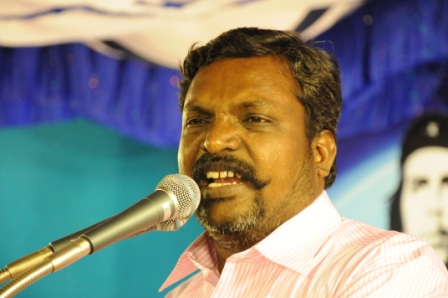Rahul Gaikwad
So the other day, I was just thinking about how and when anti-corruption rhetoric got currency in this society. We saw it at its full ugly zenith during the India Against Corruption campaign led by the Anna Hazare and Kejriwal duo, well aided by the mainstream media. Suddenly, I was reminded me of the movie, Ardh Satya (1983), for it had impacted me through showing a grim reality I had seen from close quarters. At the same time, it also reminded me how I could never relate to the protagonist, the brahmin character, ‘Velankar’. Then I thought to myself the ideal question this society should be asking is: why does Dharavi exists in the first place? Instead, this movie made sure to project that a ‘Velankar’ is as equal a victim as a Kamble or any other bahujan. That’s where I couldn’t connect and that is when I felt the narrative that was given shape through this movie formed the bedrock or was a precursor leading up to anti-corruption rhetoric which attained full vigour in 2011 during the IAC movement, or moment shall I say.

The movie is about an ‘upright Brahmin’ police sub-inspector Anant Velankar who is hounded and harassed by a slumlord, Rama Shetty, whose business interests involve all kinds of illegal activities. The movie portrays how the slumlord continues to outwit and harass this honest cop using his political connections; the movie shows how the police works with the mafia. The whole system is so corrupt that this honest cop, Velankar, finds tolerating it increasingly difficult so he fights back the whole slumlord and political-police nexus. The movie remains one of the most watched police movies from the “parallel cinema” which has got as good an audience as a mainstream film.
On further research, I realised though this movie is celebrated as a landmark and is said to be based on a novel but is actually inspired from the real life battle between the don from Dharavi-Matunga, Varadarajan Mudaliar and the then DCP YC Pawar. Then it got me thinking more: this movie just can’t be a movie based on some novel as it is claimed to be, though Vijay Tendulkar, famous Marathi playwright, wrote the screenplay for this movie. Because just a couple of years before this movie was made, IPS YC Pawar had taken Mumbai by storm. He would take on the most dreaded Dharavi don, Varadarajan, in his own daredevilry and finish his empire single-handedly. Now Mr YC Pawar came from a small town in Maharashtra and belonged to the Chambhar caste; so he was a Dalit or an officer from the Scheduled Castes who had done what no other officer had dared to do in Mumbai.
When I realised this was the actual backdrop of the movie and the actual hero was a Dalit, and when I see the movie, the protagonist is a brahmin character, ‘Velankar’, it made things clear as to how the Brahmin-Savarna never acknowledge heroes from the subaltern, all they want is just victimhood from this class, as being the oppressors they also want to be the messiahs rescuing the oppressed. This superiority complex stemming from caste makes sure Tendulkar-Nihalani can’t fathom a hero from the subaltern or Dalit background, and quite contrary to the reality, install a brahmin hero, ‘Velankar’.
If at all Dalits feature anywhere in their narratives, it is only as dumb helpless victims to be rescued by upper caste saviours (in fact, Tendulkar goes ahead of this and demonizes Dalits thourgh his play, Kanyadan). For them, any real hero coming from the subaltern, from the oppressed, is an anathema. That is why Pawar does not get any recognition from this duo and yet they are acknowledged for liberal progressive credentials by their own lot. What this shows is only caste hegemony, parallel cinema is thus parallel caste. No different from mainstream cinema, media or academia.
But as mentioned earlier I personally feel this movie played an important role in building that narrative that we all are equal victims of this menace called corruption and hence we are all equals. So Velankar is as equal a victim as a Kamble in this caste society, whereas in reality that caste is the biggest fraud/corruption that has determined the basis of all material existence and inequality in this society is completely erased through this narrative. That this anti-corruption rhetoric was pushed only to silence any discussion around caste is so obvious now.
Another “parallel movie” which is highly acclaimed is Jabbar Patel’s Marathi movie Mukta (1994). In this movie the protagonist is shown to be a Dalit man who is shown to be equally patriarchal and violent when he gets jealous of his savarna girlfriend’s black male friend and beats him up. So, as you see Dalit assertion growing from Dalit Panthers confronting the oppressor, immediately we see Jabbar Patel (who is associated with so called liberal socialist progressives in Maharashtra) painting the Dalit hero in Mukta as violently masculine towards his savarna girlfriend. This stereotype was given birth through this “parallel cinema”. This movie won some ‘national integration’ award too. No wonder this narrative was run equally effectively or rather more effectively by Brahmin academics like Sharmila Rege, concurrently, in that decade.
The movie “Court”, released in the year 2014, similarly tries to mislead in the guise of appearing progressive, while showing how the court as an institution is a failure and how the Ambedkarite activist can only be a victim who is without much voice, a sorry figure. Although it may have earned accolades globally for showing the inept judiciary, it very smartly diverted attention from the question of caste. It showed judiciary as a failure as if it is an automated/independent machinery devoid of people in flesh and blood without any caste consciousness. Representative judiciary is the need of the hour, to imagine that people become casteless just by occupying chairs based on high principles is very childish. So the savarna director Tamhane shows judges to be corrupt, inefficient and even superstitious in this movie but that remains only a individual trait and has no relation to caste or caste interests is the message sent by this movie. How do you expect such “parallel” cinema to ever speak the truth?

Even if one turns towards ‘light hearted’ movies like ‘Katha’ by Sai Paranjpye all you get to see is caste, but Brahmin this time, about “their mannerisms and their culture”. What is radical about it is difficult to understand. If some ideas about modernity or sex or lifestyle or clothes is to be considered radical then she goes beyond that all to still continue with caste endogamy through this “parallel” cinema.
Parallel cinema is thus parallel caste hardly connected with or concerned about the large majority, bahujans, of this land.
~~~
Rahul Gaikwad is an independent researcher.
Images courtesy: the internet.










